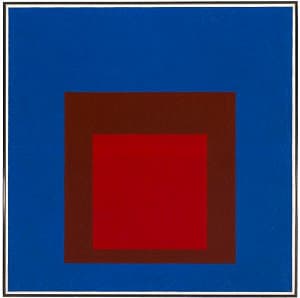

Josef Albers
Learn moreHomage to the square: On an early sky 1964
© The Josef and Anni Albers Foundation. VG Bild-Kunst/Copyright Agency Purchased 1981
More detail | PermalinkJosef Albers was born in Germany in 1888. After training and working as a primary school teacher, and attending art schools in Berlin, Essen and Munich, he studied and later taught at the Bauhaus in Weimar. Albers went on to become a full professor at the Bauhaus when it moved to Dessau in 1925 until it closed in 1933 due to Nazi repression, at which point he accepted an invitation to teach at Black Mountain College, North Carolina. Albers became an American citizen in 1939.
From the summer of 1949, Albers worked on a series of paintings in which he explored the interaction of colours in a regular format, seeking to demonstrate that colour is an entirely relative phenomenon: it changes constantly according to its juxtaposition and relationship with other colours. According to Albers:
In order to use color effectively it is necessary to recognize that color deceives continually … the same color evokes innumerable readings. Instead of mechanically applying or merely implying laws and rules of color harmony, distinct color effects are produced—through recognition of the interaction of color.[1]
Called Homage to the square, the series preoccupied him for the remainder of his career until his death in 1976. Each of the paintings in the series is based on an arrangement of squares stacked one inside the other, evenly placed on a horizontal axis and disposed with a bias to the bottom of the composition on the vertical axis. Four different formats exist, each with either three or four nested squares in slightly different configurations.
Albers produced works in this series by first making small colour sketches, which he then enlarged to a painting of 60.9 x 60.9 cm, 76.2 x 76.2 cm or 96 x 96 cm to see how the change in scale affected the interaction of the colours. These studies, according to Albers, were then observed at intervals, sometimes over a period of years, to detect possible improvements before being enlarged to their final format of 101.6 cm or 122.2 cm,[2] the largest Masonite square available and the size of Homage to the square: On an early sky 1964. In this work, the contrasts of colour are unusually intense, the light red of the middle square barely mediating between the incandescent cadmium red of the internal square and the expanse of cerulean blue. Albers subtitled his works infrequently and then only after they were completed. Yet such subtitles as On an early sky, with its naturalistic and poetic connotations, reveal Albers’ sense of the lyrical power of colour, distancing him from the more formal experiments of the Minimalists with whom he is often now associated as a precursor.
Michael Desmond and Michael Lloyd[3]
[1] Josef Albers, Interaction of colour, Yale University Press, New Haven, 1975, p 1.
[2] Josef Albers, correspondence with the Tate Gallery, 16 May 1966, cited in Ronald Alley, The catalogue of the Tate Gallery’s collection of modern art other than works by British artists, Tate Gallery, London, 1981, p 5.
[3] Adapted and updated from Michael Lloyd and Michael Desmond, European and American paintings and sculptures 1870–1970 in the Australian National Gallery, Australian National Gallery, Canberra, 1992, pp 280–3, by Christine Dixon.

